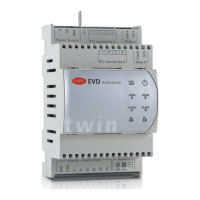ENG
“EVD Evolution TWIN” +0300006EN - rel. 2.6 - 31.01.2019
56
PROBLEM CAUSE SOLUTION
In the start-up phase with
high evaporator tempe-
ratures, the evaporation
pressure is high
MOP protection disabled or ineective Activate the MOP protection by setting the threshold to the required saturated eva-
poration temperature (high evaporation temperature limit for the compressors) and
setting the MOP integral time to a value above 0 (recommended 4 seconds). To make
the protection more reactive, decrease the MOP integral time.
Refrigerant charge excessive for the system
or extreme transitory conditions at start-up
(for showcases only).
Apply a “soft start” technique, activating the utilities one at a time or in small groups. If
this is not possible, decrease the values of the MOP thresholds on all the utilities.
In the start-up phase the
low pressure protection is
activated (only for units with
compressor on board)
The “Valve opening at start-up” parameter
is set too low
Check the calculation in reference to the ratio between the rated cooling capacity of
the evaporator and the capacity of the valve; if necessary increase the value.
The driver in conguration does not start
control and the valve remains closed
Check the connections. Check that the pCO application connected to the driver (where
featured) correctly manages the driver start signal. Check that the driver is NOT in
stand-alone mode.
The driver in stand-alone conguration
does not start control and the valve
remains closed
Check the connection of the digital input. Check that when the control signal is sent
that the input is closed correctly. Check that the driver is in stand-alone mode.
LOP protection disabled Set a LOP integral time greater than 0 sec.
LOP protection ineective Make sure that the LOP protection threshold is at the required saturated evaporation
temperature (between the rated evaporation temperature of the unit and the corre-
sponding temperature at the calibration of the low pressure switch) and decrease the
value of the LOP integral time.
Solenoid blocked Check that the solenoid opens correctly, check the electrical connections and the
operation of the relay.
Insucient refrigerant Check that there are no bubbles in the sight glass upstream of the expansion valve.
Check that the subcooling is suitable (greater than 5 °C); otherwise charge the circuit.
The valve is connected incorrectly (rotates
in reverse) and is open
Check the movement of the valve by placing it in manual control and closing or ope-
ning it completely. One complete opening must bring a decrease in the superheat and
vice-versa. If the movement is reversed, check the electrical connections.
Stator broken or connected incorrectly Disconnect the stator from the valve and the cable and measure the resistance of the
windings using an ordinary tester.
The resistance of both should be around 36 ohms. Otherwise replace the stator. Finally,
check the electrical connections of the cable to the driver.
The “Valve opening at start-up” parameter
is set too low
Check the calculation in reference to the ratio between the rated cooling capacity of
the evaporator and the capacity of the valve; if necessary lower the value.
The unit switches o due
to low pressure during
control (only for units with
compressor on board)
LOP protection disabled Set a LOP integral time greater than 0 sec.
LOP protection ineective Make sure that the LOP protection threshold is at the required saturated evaporation
temperature (between the rated evaporation temperature of the unit and the corre-
sponding temperature at the calibration of the low pressure switch) and decrease the
value of the LOP integral time.
Solenoid blocked Check that the solenoid opens correctly, check the electrical connections and the
operation of the control relay.
Insucient refrigerant Check that there are no bubbles of air in the liquid indicator upstream of the expansion
valve. Check that the subcooling is suitable (greater than 5 °C); otherwise charge the
circuit.
The valve is signicantly undersized Replace the valve with a larger equivalent.
Stator broken or connected incorrectly Disconnect the stator from the valve and the cable and measure the resistance of the
windings using an ordinary tester.
The resistance of both should be around 36 ohms. Otherwise replace the stator. Finally,
check the electrical connections of the cable to the driver (see paragraph 5.1).
Valve stuck closed Use manual control after start-up to completely open the valve. If the superheat
remains high, check the electrical connections and/or replace the valve.
The showcase does not
reach the set temperature,
despite the value being
opened to the maximum
(for multiplexed showcases
only)
Solenoid blocked Check that the solenoid opens correctly, check the electrical connections and the
operation of the relay.
Insucient refrigerant Check that there are no bubbles of air in the liquid indicator upstream of the expansion
valve. Check that the subcooling is suitable (greater than 5 °C); otherwise charge the
circuit.
The valve is signicantly undersized Replace the valve with a larger equivalent.
Stator broken or connected incorrectly Disconnect the stator from the valve and the cable and measure the resistance of the
windings using an ordinary tester.
The resistance of both should be around 36 ohms. Otherwise replace the stator. Finally,
check the electrical connections of the cable to the driver (see paragraph 5.1).
Valve stuck closed Use manual control after start-up to completely open the valve. If the superheat
remains high, check the electrical connections and/or replace the valve.
The showcase does not
reach the set temperature,
and the position of the valve
is always 0 (for multiplexed
showcases only)
The driver in conguration does not start
control and the valve remains closed
Check the connections. Check that the pCO application connected to the driver (where
featured) correctly manages the driver start signal. Check that the driver is NOT in
stand-alone mode.
The driver in stand-alone conguration
does not start control and the valve
remains closed
Check the connection of the digital input. Check that when the control signal is sent
that the input is closed correctly. Check that the driver is in stand-alone mode.
Tab. 10.a

